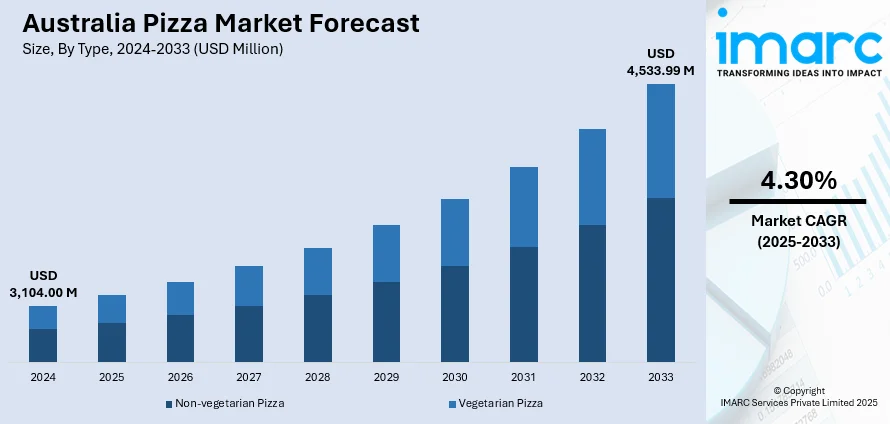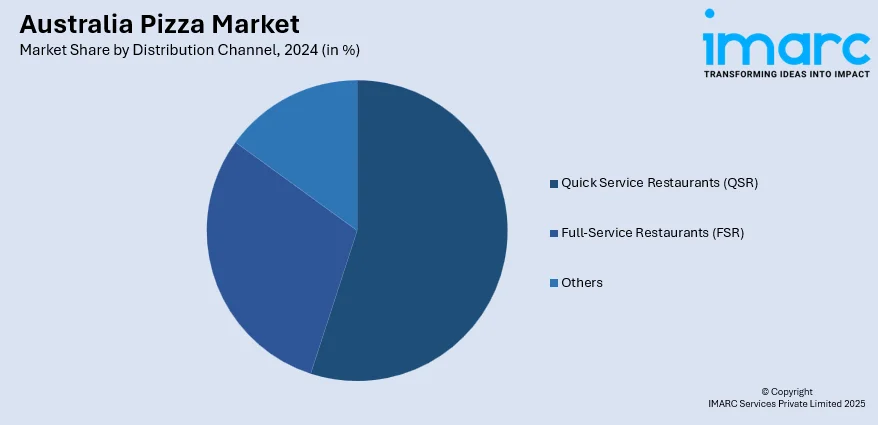
Australia Pizza Market Size, Share, Trends and Forecast by Type, Crust Type, Distribution Channel, and Region, 2025-2033
Australia Pizza Market Overview:
The Australia pizza market size reached USD 3,104.00 Million in 2024. Looking forward, the market is projected to reach USD 4,533.99 Million by 2033, exhibiting a growth rate (CAGR) of 4.30% during 2025-2033. The market is being driven by increasing demand for convenient delivery services, improved health-consciousness leading to healthier pizza options, and the rise of innovative and customized menu offerings, such as unique toppings and themed promotions, which cater to diverse consumer preferences and enhance brand differentiation in a competitive industry.
|
Report Attribute
|
Key Statistics
|
|---|---|
|
Base Year
|
2024
|
|
Forecast Years
|
2025-2033
|
|
Historical Years
|
2019-2024
|
| Market Size in 2024 | USD 3,104.00 Million |
| Market Forecast in 2033 | USD 4,533.99 Million |
| Market Growth Rate 2025-2033 | 4.30% |
Key Trends of Australia Pizza Market:
Increasing Demand for Convenience and Delivery Services
The growing demand for convenience is a significant factor driving the Australian pizza market. As urban lifestyles become increasingly hectic, particularly in metropolitan areas, consumers are seeking quick, convenient, and easily accessible food options. Pizza, readily available through various delivery platforms, effectively meets this growing Australia pizza market demand. Contemporary consumers value the convenience of online food ordering, prompting pizza chains to enhance their delivery systems. This includes partnerships with food delivery services such as Uber Eats, Deliveroo, and Menulog, facilitating faster and more efficient service. The appeal of convenience extends beyond delivery; the option to place an order online and have it delivered to one's residence is attractive to a wide demographic, including young professionals and families. Furthermore, the rising demand for home delivery correlates with an increased desire for customization. Pizza offers a flexible solution for consumers to personalize their orders, allowing them to select from a variety of toppings, crust options, and sizes. With the growing number of individuals working remotely, coupled with time constraints and health concerns limiting dining out, the expansion of the delivery and takeaway sector has become a crucial driving force in the market.

To get more information on this market, Request Sample
Rise of Health-Conscious Consumers and the Demand for Healthier Pizza Options
A notable factor contributing to the growth of the Australian pizza market is the increasing health consciousness among consumers. Australians are becoming increasingly aware of their health, which is influencing their food preferences. In response to this shift, pizza companies have introduced healthier options to cater to the needs of health-conscious consumers. These offerings include gluten-free crusts, vegan cheese, low-calorie pizzas, and pizzas made with nutritious ingredients such as vegetables, lean proteins, and whole-grain crusts. Such options are particularly popular among younger consumers and individuals with specific dietary restrictions, including gluten or lactose intolerance. In addition to these healthier alternatives, many Australian pizza chains are now providing lower-sodium, reduced-fat, and more nutrient-dense products. This not only meets the demands of health-conscious individuals but also caters to the growing interest in functional foods. For instance, some pizzas feature superfoods such as spinach, kale, and quinoa while also providing plant-based options in place of traditional meat toppings. As Australians continue to prioritize balanced diets while still seeking indulgent meals, the demand for healthier pizza options is expected to continue driving market growth.
Customization and Build-Your-Own Trends Gaining Popularity
According to Australia pizza market analysis, the demand for personalized dining experiences is reshaping how pizza is offered and consumed. There is a growing demand for control over ingredients, portion sizes, and nutritional content, which has led to a rise in customizable and build-your-own pizza options. Many restaurants and chains are now implementing interactive menus, enabling customers to choose their crust type, sauces, proteins, vegetables, and even cooking methods. This trend caters to a wide array of dietary preferences, including gluten-free, keto, vegetarian, and vegan diets. Additionally, it improves customer satisfaction by providing flexibility and creativity in meal choices. As personalization becomes an essential value in the food industry, customizable pizzas are significantly enhancing customer loyalty and competitive positioning in the market.
Growth Factors of Australia Pizza Market:
Changing Lifestyles and Urbanization
With the pace of urban life accelerating, Australians are increasingly leaning toward convenient food options that match their hectic schedules. Pizza, famous for its quick preparation and accessibility, has emerged as a favored choice for busy consumers, especially in urban settings. The rise of dual-income households and the trend of on-the-go eating have fueled the demand for both dine-in and delivery options. Quick-service pizza restaurants, food delivery apps, and cloud kitchens are responding to this shift by providing speed, variety, and straightforward ordering processes. This consumer preference for convenience continues to play a crucial role in influencing product offerings and service models in Australia’s pizza market, driving steady growth in cities.
Growing Demand for Premium and Gourmet Options
In Australia, consumer tastes are shifting toward high-quality, gourmet dining experiences, even in the fast-food and casual dining sectors. This change is apparent in the increasing popularity of premium and artisanal pizzas that utilize fresh, locally sourced ingredients, handcrafted crusts, and innovative flavor profiles. Consumers are becoming more willing to invest in their meals for superior taste, transparent ingredient sourcing, and chef-designed recipes. Pizza establishments are responding with curated menus that highlight authenticity, quality, and health-conscious options. These offerings attract a more discerning clientele, boosting brand loyalty and customer satisfaction. Consequently, the trend toward premiumization is significantly enhancing Australia pizza market share by broadening its appeal to a more upscale demographic.
Expansion of Frozen and Retail Pizza Offerings
The segment of frozen and ready-to-eat pizzas in Australia is gaining considerable momentum, driven by the desire for convenient home meal solutions. As consumers look for adaptable dining options that align with busy lifestyles or remote work habits, supermarkets are expanding their range of frozen pizzas to include gourmet, plant-based, and specific dietary options. Advances in freezing technology and enhanced packaging have improved product quality, making frozen pizzas a dependable and tasty choice compared to takeaway. This trend also appeals to budget-conscious shoppers who seek value without sacrificing taste or variety. With more households considering ready-to-cook pizzas as pantry essentials, the retail sector is significantly impacting Australia pizza market growth and altering consumption patterns.
Australia Pizza Market Segmentation:
IMARC Group provides an analysis of the key trends in each segment of the market, along with forecasts at the region/country level for 2025-2033. Our report has categorized the market based on type, crust type, and distribution channel.
Type Insights:
- Non-vegetarian Pizza
- Vegetarian Pizza
The report has provided a detailed breakup and analysis of the market based on the type. This includes non-vegetarian pizza and vegetarian pizza.
Crust Type Insights:
- Thick Crust
- Thin Crust
- Stuffed Crust
A detailed breakup and analysis of the market based on the crust type have also been provided in the report. This includes thick crust, thin crust, and stuffed crust.
Distribution Channel Insights:

- Quick Service Restaurants (QSR)
- Full-Service Restaurants (FSR)
- Others
The report has provided a detailed breakup and analysis of the market based on the distribution channel. This includes quick service restaurants (QSR), full-service restaurants (FSR), and others.
Regional Insights:
- Australia Capital Territory & New South Wales
- Victoria & Tasmania
- Queensland
- Northern Territory & Southern Australia
- Western Australia
The report has also provided a comprehensive analysis of all the major regional markets, which include Australia Capital Territory & New South Wales, Victoria & Tasmania, Queensland, Northern Territory & Southern Australia, and Western Australia.
Competitive Landscape:
The market research report has also provided a comprehensive analysis of the competitive landscape. Competitive analysis such as market structure, key player positioning, top winning strategies, competitive dashboard, and company evaluation quadrant has been covered in the report. Also, detailed profiles of all major companies have been provided.
Australia Pizza Market News:
- February 2025: Domino's Australia introduced its first-ever Quick Service Restaurant (QSR)-exclusive menu items: Pizza Pots and Lava Pots. Both items are designed to cater to the growing demand for convenient, on-the-go snacking options in Australia.
- August 2024: Domino’s Australia introduced Afterpay as a payment option, allowing customers to enjoy their pizzas now and pay later in four interest-free installments over six weeks. This initiative responds to growing demand for flexible payment methods and aligns with Domino’s commitment to offering greater choice and convenience.
- June 2023: Flynn Restaurant Group acquired Pizza Hut Australia from Allegro Funds. This acquisition added approximately 260 Pizza Hut locations to Flynn's portfolio, which includes over 2,600 restaurants globally.
Australia Pizza Market Report Coverage:
| Report Features | Details |
|---|---|
| Base Year of the Analysis | 2024 |
| Historical Period | 2019-2024 |
| Forecast Period | 2025-2033 |
| Units | Million USD |
| Scope of the Report |
Exploration of Historical Trends and Market Outlook, Industry Catalysts and Challenges, Segment-Wise Historical and Future Market Assessment:
|
| Types Covered | Non-vegetarian Pizza, Vegetarian Pizza |
| Crust Types Covered | Thick Crust, Thin Crust, Stuffed Crust |
| Distribution Channels Covered | Quick Service Restaurants (QSR), Full-Service Restaurants (FSR), Others |
| Regions Covered | Australia Capital Territory & New South Wales, Victoria & Tasmania, Queensland, Northern Territory & Southern Australia, Western Australia |
| Customization Scope | 10% Free Customization |
| Post-Sale Analyst Support | 10-12 Weeks |
| Delivery Format | PDF and Excel through Email (We can also provide the editable version of the report in PPT/Word format on special request) |
Key Benefits for Stakeholders:
- IMARC’s industry report offers a comprehensive quantitative analysis of various market segments, historical and current market trends, market forecasts, and dynamics of the Australia pizza market from 2019-2033.
- The research report provides the latest information on the market drivers, challenges, and opportunities in the Australia pizza market.
- Porter's five forces analysis assist stakeholders in assessing the impact of new entrants, competitive rivalry, supplier power, buyer power, and the threat of substitution. It helps stakeholders to analyze the level of competition within the Australia pizza industry and its attractiveness.
- Competitive landscape allows stakeholders to understand their competitive environment and provides an insight into the current positions of key players in the market.
Key Questions Answered in This Report
The pizza market in Australia was valued at USD 3,104.00 Million in 2024.
The Australia pizza market is projected to exhibit a compound annual growth rate (CAGR)of 4.30% during 2025-2033.
The Australia pizza market is expected to reach a value of USD 4,533.99 Million by 2033.
The major trends of the market include rising plant-based and allergen-free options, increased focus on sustainable packaging, and growing popularity of limited-edition or seasonal flavors. DIY pizza kits and hybrid pizza styles are also gaining traction, appealing to adventurous and home-based consumers.
Key drivers include rising disposable incomes, increased frequency of casual dining, and strong marketing by pizza chains. The affordability and family-friendly appeal of pizza, coupled with expanding store networks in suburban and regional areas, are also contributing to sustained demand and market expansion.
Need more help?
- Speak to our experienced analysts for insights on the current market scenarios.
- Include additional segments and countries to customize the report as per your requirement.
- Gain an unparalleled competitive advantage in your domain by understanding how to utilize the report and positively impacting your operations and revenue.
- For further assistance, please connect with our analysts.
 Request Customization
Request Customization
 Speak to an Analyst
Speak to an Analyst
 Request Brochure
Request Brochure
 Inquire Before Buying
Inquire Before Buying




.webp)




.webp)












